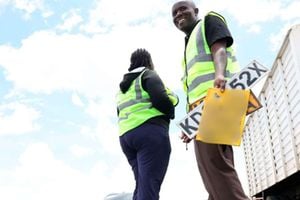31st World Aids Day: To all those who survived disease

An HIV/Aids screening test during a past World Aids Day. PHOTO | FILE | NATION MEDIA GROUP
What you need to know:
- When it was introduced in 1988, it was impossible that anyone would be alive today to reflect on the fact that new HIV infections have been reduced by 40 per cent since the peak in 1997.
At the end of 2018, nearly 38 million people globally were living with HIV, and about 25 million people were accessing antiretroviral therapy.
In the years between 1988 and 2004, if you lived in Africa, you had little hope.
Sunday, December 1, will be the 31st anniversary World Aids Day.
Since the beginning of the epidemic, more than 70 million people have been infected with HIV, and about 35 million people have died.
HARDEST HIT
When it was introduced in 1988, it was impossible — especially from the grim view from Uganda then — that anyone would be alive today to reflect on the fact that, according to UNAIDS, new HIV infections have been reduced by 40 per cent since the peak in 1997, and Aids-related deaths have been reduced by more than 56 per cent since the peak in 2004.
At the end of 2018, nearly 38 million people globally were living with HIV, and about 25 million people were accessing antiretroviral therapy. In the years between 1988 and 2004, if you lived in Africa, you had little hope.
Today, Sub-Saharan Africa, with more than two-thirds of all people living with HIV globally, is the hardest hit region. Bad as that is, on HIV and Aids, the world, and Africa, have still scored an epic victory.
EXTINCTION
Few diseases have shaken and changed the world, in part because of its democratic nature. It struck at the great big junction where the currents that bring the low and mighty of human society meet — pleasure, lust, love, recreation, procreation and commerce.
In the 1980s and 1990s, HIV and Aids was all there was. But many conservative African societies that couldn’t discuss sex openly and considered condoms a product manufactured by Satan, caved when they were faced by extinction, and allow open and bold campaigns.
HIV and Aids battered several sectors of economies. I remember reading a story in an international newspaper about how a whole Barclays Bank branch in the Zambia capital, Lusaka, had been wiped out by Aids.
In the early period, emerging from many years of war, and a confluence of the traffic between the east African coast and central Africa, Uganda was ravaged mercilessly by Aids. It launched the most open-minded and outspoken campaign, and, in the end, it became the first country to stem and receive the advance of HIV/Aids.
SHAMEFACED
But nothing really is still able to capture the horror of the times. We would scupper from the newsroom every other week, to describe the shocking face of the epidemic: An entire village where adults had died and all that remained were children-led homes.
Once, with friends, we were chasing a motor rally in the countryside in the south of Uganda. We found a mound in a homestead at a sharp corner that offered a spectacular view. During a pause, we looked around. The homestead had a small compound, but it had about 20 tombstones.
As it became clear what we were looking at, a frail woman leaning emerged from the corner of what we thought was a deserted home. She stood there and stared at us blankly. We slinked away shamefaced.
In the east near the river Nile, a friend who was an extreme tree-hugger, had gone back to the countryside to build an earth movement. Not too far away from his site, a preacher had emerged promising to cure Aids with prayer and a wash in a holy water he concocted. He was all the rage, and raking in millions.
Daily, newspapers denounced him as a despicable con man exploiting the desperate.
SHAKEN
My friend, a very scientific chap, called and asked me to go and see why the preacher was in business. He took me to the preacher, and I listened to his story.
Then he told me, “Let’s walk”. We walked to a village about two kilometres away. Many homes were empty, their doors open, fallen mangoes strewn and rotting all over the bushy compounds.
There were many mangy dogs about. We came upon a home with a sickly child of about one year crawling alone in the compound. A few homes later, there was an old woman in the last stages of life.
We didn’t see another sign of life in the village.
At the end, he told me. “Aids happened to this village”, adding that “if this is your reality, the preacher’s lie is the only hope you have”. I was shaken to the marrow.
FLOURISHING
Years later I drove through the same village. There was a tarmac road, a flourishing town, and everywhere I looked there were rice paddies.
On World Aids Day, we remember the tragedy. But also, we celebrate the small and precious trophies we won.
Mr Onyango-Obbo is curator of the “Wall of Great Africans” and publisher of explainer site Roguechiefs.com. Twitter@cobbo3





